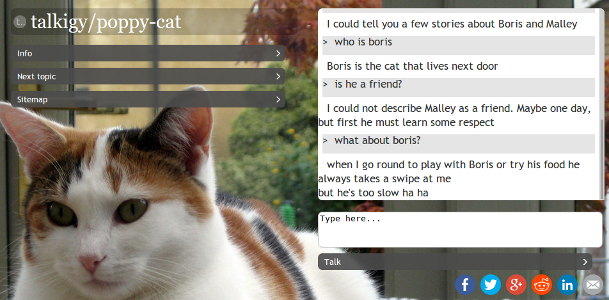A few years ago, I installed a spam filter called Spambayes on a PC and was completely fascinated by its ability to learn and be effective. Given a few dozen spam emails and a few 'hams', Spambayes could learn to filter thousands of diverse emails successfully. When it made a mistake, it was easy to 'teach' and very quickly, it achieved something close to perfection, something close to magic.

Poppy at www.talkigy.com
I was fascinated by the intelligence of Spambayes and this lead me to research how it worked, and what else might be done with such 'magical' intelligence. Spambayes makes use of Bayes' theorem, which concerns the probability of 'B' happening given that 'A' has already happened. The fairly simple maths that Reverend Bayes derived in the 1800s is still in use today and has many applications, from predicting what music you will like given your movie preferences or guessing what language a text is written in. Bayes' is simple but effective. Here is an example using Python that identifies the sentiment of some text as positive or negative (using the 'text' library as shown here):
from text.classifiers import NaiveBayesClassifier
train = [('I love this sandwich.', 'pos'),
# ... more training examples here ...
('My boss is horrible.', 'neg')]
cl = NaiveBayesClassifier(train)
# Classify some text
print(cl.classify("Their burgers are amazing.")) # "pos"
print(cl.classify("I don't like their pizza.")) # "neg"
Experimenting with Python and Bayes led me to discover that there were many other 'magical' techniques (and vast university departments studying them under the headings of 'Information Science' or 'Artificial Intelligence'). I discovered the excellent book, 'Programming Collective Intelligence' by Toby Seagaran, which provides clear explanations of the basic theories together with practical applications. This set me on a path of discovery and experimentation. Twenty months later the result was www.talkigy.com. Talkigy is a chatbot (or chatterbot) that can be trained in a given topic. So far there are three example data banks:
- about-talkigy: chat about talkigy.
- poppy-cat: chat with arguably the world's leading chatting cat.
There are many other chatbots out there (for example 'cleverbot' used by MI5 for recruitment, and Eliza, the surprisingly effective therapist based on a standard mark-up language, AIML for creating AI).
Talkigy's approach to artificial intelligence is simple. Rather than 'thinking' too much, it simplifies language using stems and synonyms and then matches patterns in input received with patterns in its response bank. Talkigy is a publishing medium that connects users to the content that interests them while stimulating them into an interaction. For example, instead of reading this blog post, you could explore similar content by chatting with talkigy about talkigy. Click on the chat icon at the bottom right of this page.`_
Alternatively, you may just want to chat with a cat
